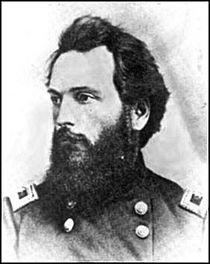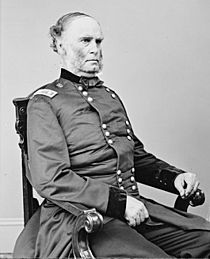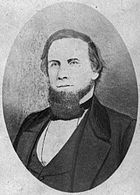Battle of Cotton Plant facts for kids
The Battle of Cotton Plant, also known as the Action at Hill's Plantation, happened on July 7, 1862. It was a fight during the American Civil War in Woodruff County, Arkansas.
The Union Army, led by General Samuel Ryan Curtis, was trying to march to Little Rock. But they ran out of supplies. So, they decided to move south along the White River instead.
Near Cotton Plant, Curtis's army met a Confederate force. This group was led by General Albert Rust. Rust's soldiers were on the east side of the Cache River. Only two Texas cavalry (horseback) regiments from Rust's side joined the battle.
These Confederate horsemen attacked the Union's lead group. This group was commanded by Charles Edward Hovey. After a tough fight, more Union soldiers arrived. They pushed back the Texans. Rust's force had to retreat in a hurry. Curtis's army then marched south to Clarendon. From there, they went east to take over Helena on the Mississippi River.
Quick facts for kids Battle of Cotton PlantAction at Hill's Plantation |
|||||||
|---|---|---|---|---|---|---|---|
| Part of the Trans-Mississippi Theater of the American Civil War |
|||||||
 Map of Hill's Plantation Battlefield core and study areas by the American Battlefield Protection Program. |
|||||||
|
|||||||
| Belligerents | |||||||
| Commanders and leaders | |||||||
| Samuel Ryan Curtis Charles E. Hovey William P. Benton |
Thomas C. Hindman Albert Rust William H. Parsons |
||||||
| Units involved | |||||||
| Army of the Southwest | 12th Texas Cavalry 16th Texas Cavalry |
||||||
| Strength | |||||||
| 10,000 Engaged: 600+ |
5,000 Engaged: Two regiments |
||||||
| Casualties and losses | |||||||
| 63 | 90–250 | ||||||
Contents
Why the Battle Happened
War in Arkansas: Early 1862
A few weeks after the Union won the Battle of Pea Ridge in March 1862, Union General Curtis heard news. He learned that Confederate General Earl Van Dorn's army was moving east. On April 5, Curtis's boss, General Henry Halleck, told him to move east. This was to stop any possible attack from Van Dorn.
So, the Union Army of the Southwest marched east. They went through towns like Cassville and West Plains in Missouri. But Van Dorn's troops were actually ordered to go to Corinth, Mississippi. A large Confederate army was gathering there. Van Dorn quickly moved his soldiers, leaving Arkansas with few troops or supplies. His troops arrived too late to fight in the Battle of Shiloh in April, which the Confederates lost.
Union Army Tries to Reach Little Rock
After the Battle of Shiloh, General Halleck told Curtis to go into northeast Arkansas. He was to meet another Union force led by General Frederick Steele. Curtis's army marched south from White Plains. They crossed into Arkansas on April 29 and reached Batesville, Arkansas on May 2. Steele's soldiers arrived nearby on May 4.
However, Halleck then ordered Curtis to send half of his infantry (foot soldiers) to Missouri. These soldiers would then go east of the Mississippi River. Curtis followed orders. He sent several regiments under Generals Jefferson C. Davis and Alexander Asboth to Halleck. Curtis then reorganized his remaining soldiers into three main groups.
Halleck then told Curtis to take Little Rock, which was about 100 miles (160 km) south. In May, Curtis's army had about 6,000 infantry, 3,000 cavalry, and 1,000 artillery (cannon) soldiers.
The Union army taking Batesville made Arkansas Governor Henry Massey Rector call out the state's citizen soldiers. He also moved the state's important papers from Little Rock. Confederate General John Selden Roane complained he had no troops or weapons. He promised to stop all Texas units passing through Arkansas. General P. G. T. Beauregard then put General Thomas C. Hindman in charge of the Confederate forces in the area. Hindman quickly gathered an army of about 4,000 Texas cavalry and 1,500 Arkansas infantry.
On May 7, a part of Curtis's army crossed the White River. Four days later, they reached the Little Red River near Searcy. In the Battle of Whitney's Lane on May 19, 1862, Texas cavalry attacked Union soldiers looking for food. They killed 15, wounded 32, and two went missing. The next day, more Union soldiers arrived at the Little Red River, ready to keep moving.
But that day, Curtis got a message. His supply officer said the army could no longer get supplies. The supply line was too long, about 300 miles (480 km) from the nearest rail line. So, Curtis had to give up his plan to take Little Rock.
Moving Down the White River
On May 27, Curtis sent his cavalry to raid Confederate areas south of the Little Red River. This helped Union soldiers gather more supplies. But on June 4, the Union forces went back to Batesville. Curtis warned Halleck that their supply situation was so bad, they might have to retreat to Missouri.
Meanwhile, a Union naval expedition was sent up the White River. It carried 100,000 bushels of grain and 2,500 bales of hay for Curtis's army. In the Battle of St. Charles on June 17, the expedition faced trouble. A Confederate cannonball hit the USS Mound City. This killed half its crew and injured most of the rest. Still, the expedition continued upriver. It reached Clarendon but stopped because the water was too shallow.
When Curtis learned the expedition was stuck, he decided to move his army down the White River towards Clarendon. To do this, he had to cut off his supply line to Missouri. His soldiers would have to live off the land. The Union Army left Batesville at the end of June. As they marched, they took food and destroyed property. Many African-American slaves left their plantations and joined the army. Over 3,000 joined the march, while others headed for Missouri.
On June 24, 1862, General Hindman learned that Curtis's army was moving south. Hindman sent a Texas cavalry regiment to raid across the White River. Hindman said they captured 200 Union soldiers and some supply wagons. But Union cavalry drove them off.
Hindman ordered General Rust to cross to the east side of the White River at Des Arc. Rust was to move upstream and block the Union army behind the Cache River. Rust's force grew to 5,000 troops at Cotton Plant. Rust was told to block roads, burn bridges, and destroy food. But he did not do this. Hindman stayed at DeVall's Bluff with about 2,000 soldiers. He wanted to stop the Union river expedition. He also armed a steamboat with a large cannon to guard the White River. Hindman planned to leave 500 men at Devall's Bluff and reinforce Rust. But it was too late. Curtis's army had already crossed the Cache River.
The Battle of Cotton Plant
On July 7, 1862, the Union Army reached James Ferry on the Cache River. They found the water was low enough to cross. Colonel Charles Edward Hovey, who led a group in the Union's 1st Division, sent Colonel Charles Harris ahead. Harris had 400 soldiers to scout the area. His group included soldiers from Wisconsin, Illinois, and Indiana, plus one cannon.
Harris led his force south to a road crossing at Parley Hill's Plantation. This was about 3 miles (4.8 km) northwest of Cotton Plant. Harris directed his troops down the road towards Cotton Plant. However, Hovey learned that a Union soldier was captured. He called Harris back and told him to take a different road that led southwest.
General Rust's Confederate force had five Texas cavalry regiments, three Arkansas infantry regiments, and one artillery battery. Rust ordered Colonel William H. Parsons to hold the river crossing at James Ferry. Parsons had 1,000 horsemen from his own 12th Texas Cavalry Regiment and the 16th Texas Cavalry Regiment. The day before, the 12th Texas was ready to move. But Parsons waited for the 16th Texas, which was slow. So the 12th Texas camped about 6 miles (9.7 km) south of the crossing. Around 9:00 am, Parsons heard that Union soldiers were crossing the Cache at James Ferry. He turned northeast to follow the road and sent 20 horsemen ahead.
Hovey kept one Wisconsin company at the road crossing. He sent Harris forward with the rest. Harris's Wisconsin companies passed a house and a cornfield. Then they entered a forest, spread out to fight. One Illinois company and the cannon supported them. Three other Illinois companies were further back. As the Wisconsin soldiers moved through the bushes, they saw Parsons's horsemen. The first shots were fired from about 40 yards (37 m) away. At least three Texans were hit right away. Harris pushed forward, but his soldiers were hit by a lot of fire. This happened when they ran into the main part of the 12th Texas. Harris was wounded but kept leading his men.
The Texas cavalry charged on horseback, pushing back the Wisconsin troops. Edward M. Pike earned the Medal of Honor for saving the Union cannon from being captured. Hovey ordered the Wisconsin companies, the supporting Illinois company, and the gun to retreat back to the crossing. Hovey sent the remaining three Illinois companies to hide in the cornfield. As Parsons's horsemen burst from the trees, chasing the Wisconsin soldiers, the Union soldiers in the cornfield fired at them. Many Texans fell from their horses. The Texas cavalry retreated into the forest. Hovey held his position and waited for the next Confederate move. Parsons's horsemen pulled back behind a swamp.
General Rust tried to separate Hovey's force from Curtis's main army. Rust went with Colonel James R. Taylor's 17th Texas Cavalry Regiment in a wide circle to the northeast. The horsemen went through Cotton Plant and got close to the road crossing. But as they got near, the Confederates heard a drum. Many Union soldiers stood up. The Texas regiment pulled back. These Union troops were the Wisconsin and Illinois companies and the cannon that had regrouped.
Soon after, 200 Union reinforcements arrived. These were from the 1st Indiana Cavalry. Two more cannons also arrived. After the cannons fired, Hovey organized another attack. After about 20 minutes of fighting, the Confederates fell back. Later, General William P. Benton's group from the 1st Division reached the battlefield. They continued to chase the Confederates. The Confederate retreat towards Des Arc became a wild escape. That evening, the Confederates crossed the lower Cache River and destroyed their boats. This stopped the Union from chasing them further.
After the Battle
The Union army reported losing six killed and 57 wounded in the battle. They claimed to have killed 138 Confederates and 66 horses. One estimate said Confederate losses were 250. Another source estimated 30 killed and 50–60 wounded for the Confederates. One Texan reported that the 12th Texas lost 14 killed, 20 seriously wounded, 16 slightly wounded, and two missing. He thought the 16th Texas lost about the same.
General Curtis continued to Clarendon. His troops reached it on July 9. But they found that the Union supply boats had left the day before. The boats could not connect with Curtis's army and would not wait any longer. Curtis ordered cannons to be fired and sent messengers downriver. But the boats disappeared. Curtis had hoped to continue his advance on Little Rock using the White River for supplies. Now, he realized getting supplies was the most important thing.
So, he turned his army towards Helena, which was about 45 miles (72 km) to the east. The Union Army of the Southwest took over Helena without any fighting on July 12. This was after a very hard march in intense heat and dust. Union troops cheered when they saw boats on the Mississippi River. The army was soon resupplied. Curtis set up his headquarters in General Hindman's house.
In mid-1862, Union military operations in the Western area stopped for a while. For several months, Curtis's troops stayed in Helena. Many people who traded cotton came to Helena. The regiments from the Army of the Southwest eventually joined the Army of the Tennessee. Union forces held Helena for the rest of the war. On July 4, 1863, the Helena soldiers fought off a Confederate attack in the Battle of Helena.




